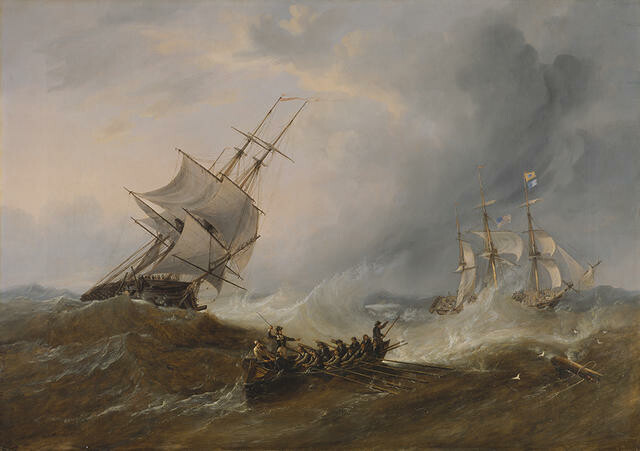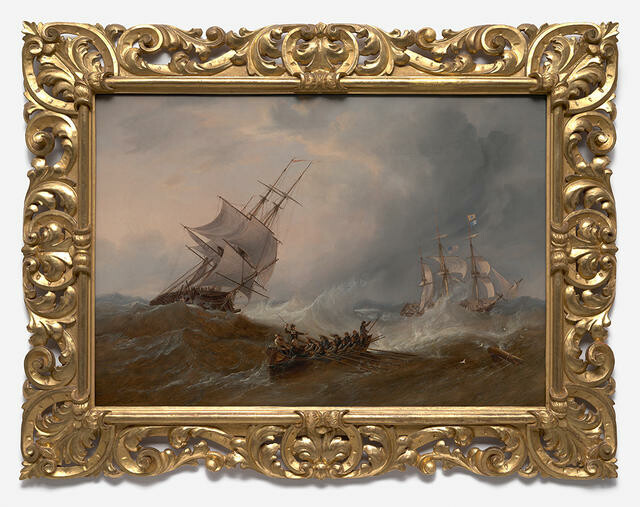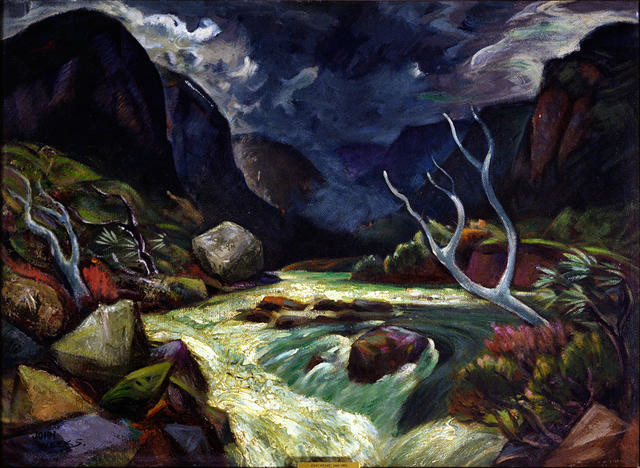John Wilson Carmichael
British, b.1799, d.1868
Shannon and the Chesapeake
- 1841
- Oil on canvas
- Bequeathed by Major A C D Spencer to the Canterbury Society of Arts, 1931 and presented to the Gallery in 1932
- 1030 x 1340 x 65mm
- 69/522
- View on google maps
Tags: battles, boats, clouds, history paintings, people (agents), sails (equipment), seas, seascapes, ships, storms
John Wilson Carmichael, son of a Newcastle upon Tyne shipwright, went to sea as a boy and trained as a shipbuilder before becoming a leading maritime and landscape painter. Here he commemorates a famous 1813 British victory in a naval battle that occurred just outside Boston Harbour, following America’s 1812 declaration of war. The conflict left many dead and wounded, including the captain of the British frigate HMS Shannon.
(Out of Time, 23 September 2023 – 28 April 2024)
There is more information on this painting in the article 'Works from Collection' in Bulletin No.80.
Exhibition History
In 1813, after the United States declared war on Britain, there was a battle between these two sailing ships outside Boston Harbour. The British captain of the Shannon, Sir Philip Bowes Vere Broke, is shown heroically, being rowed towards the Chesapeake in a stormy sea. John Wilson Carmichael has rather dramatised the event - it occurred in a calm sea and lasted just fifteen minutes. Carmichael was keenly interested in the exploits of the Royal Navy and this work belongs to the traditions of marine painting, which emerged as a separate category of painting in the 17th century. Born in Newcastle-on-Tyne, Carmichael was the son of a ship’s carpenter and was apprenticed as a ship builder. However, he established himself as a painter in 1823, initially working with water-colours. He was employed by the Illustrated London News as a war artist to record the Crimean War and in 1859 he published The Art of Marine Painting in Watercolours.
(Label date unknown)
The painter of this work, John Carmichael, was born in Newcastle-on-Tyne. At an early age he went to sea and became familiar with shipping.
Following this experience he began training as an artist and became a pupil of Thomas Miles Richardson senior (1784 - 1848). For a while he also worked as a designer in a ship building office and carried out colour work for Newcastle architect John Dobson before turning completely to painting.
Until 1825 much of his work was in watercolour often taking his inspiration from the Northumberland coast landscape.
However, he was keenly interested in the exploits of the Royal Navy and incidents from British naval history often featured in his painting. This work is an example of that interest and it is thought that it was painted in 1841 to commemorate the deeds of Admiral Sir Philip Bowes Vere Broke who died that year.
Broke, or ‘Brave Broke’ as he became known, was the central figure in a duel that occurred outside Boston Harbour on 1 June 1813. This engagement was just one of many that took place in American waters in 1813 after the United States declared war on Britain. The Americans were confident of success as ‘Chesapeake’ carried 50 guns and a crew of 376 but proved no match for Broke’s highly disciplined men who had learned their skills during the war with France.
Carmichael’s depiction of the fight is highly dramatised. Captain Broke is shown heroically, with his sword raised, being rowed towards ‘Chesapeake’ in a stormy sea.
In fact the duel occurred in a calm sea and lasted just fifteen minutes. Broke was severely wounded but later recovered and continued his service in the Royal Navy.
When Broke fell wounded Povo Wallis his second lieutenant took command and escorted the captured ‘Chesapeake’ to Halifax in Nova Scotia. As a result of the conflict the total casualties were 71 killed and 174 wounded.
The British victory eventually became part of Naval folklore and was even celebrated in a popular Victorian song.
(Label date unknown)
![Andreas Cellarius Hypothesis Ptolemaica Sive Communis Planetarum Motus Per Eccentricos Et Epicyclos Demonstrans [The Ptolemaic Hypothesis or Common Representation Demonstrating the Planetary Motions through Eccentrics and Epicycles] 1661. Hand-coloured engraving. Collection of Christchurch Art Gallery Te Puna o Waiwhetū, William A. Sutton bequest, 2000](/media/cache/05/97/05970cdff0f6b3264062d69bf2aa90f5.jpg)




![La Corvette l'Astrolabe tombant tout-à-coup sur des récifs dans la baie de l'Abondance, (Nouvelle Zélande) [The Corvette Astrolabe falling suddenly on reefs in the Bay of Plenty, (New Zealand)]](/media/cache/32/3c/323cf179e14ea0d7329b8272966fc828.jpg)

![Storm Clouds, Blythburgh, Suffolk [also known as Suffolk Village]](/media/cache/9a/42/9a4264afac7cbdf432999e96c83df21f.jpg)